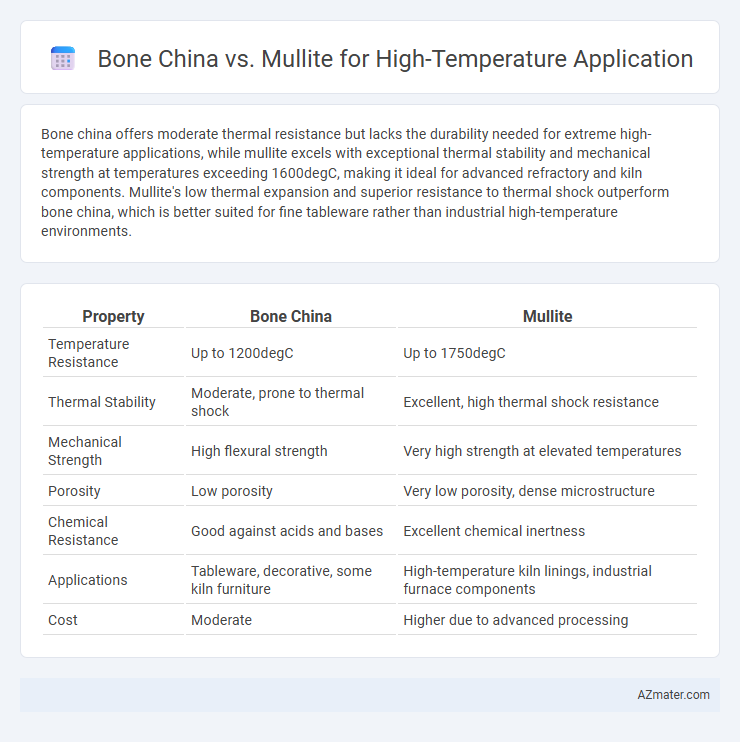Bone china offers moderate thermal resistance but lacks the durability needed for extreme high-temperature applications, while mullite excels with exceptional thermal stability and mechanical strength at temperatures exceeding 1600degC, making it ideal for advanced refractory and kiln components. Mullite's low thermal expansion and superior resistance to thermal shock outperform bone china, which is better suited for fine tableware rather than industrial high-temperature environments.
Table of Comparison
| Property | Bone China | Mullite |
|---|---|---|
| Temperature Resistance | Up to 1200degC | Up to 1750degC |
| Thermal Stability | Moderate, prone to thermal shock | Excellent, high thermal shock resistance |
| Mechanical Strength | High flexural strength | Very high strength at elevated temperatures |
| Porosity | Low porosity | Very low porosity, dense microstructure |
| Chemical Resistance | Good against acids and bases | Excellent chemical inertness |
| Applications | Tableware, decorative, some kiln furniture | High-temperature kiln linings, industrial furnace components |
| Cost | Moderate | Higher due to advanced processing |
Introduction to High-Temperature Ceramics
High-temperature ceramics such as bone china and mullite are engineered for thermal stability and mechanical strength in extreme environments. Mullite exhibits superior thermal shock resistance and stability up to 1,730degC, making it ideal for furnace linings and kiln components. Bone china, while prized for its translucency and strength in tableware, lacks the thermal endurance and insulation properties required for high-temperature industrial applications.
What is Bone China? Composition and Properties
Bone china is a type of porcelain composed primarily of bone ash (about 30-45%), kaolin, and feldspathic material, offering high whiteness and translucency. Its unique composition provides exceptional strength, chip resistance, and a smooth, glass-like surface, making it ideal for tableware but less suitable for high-temperature industrial applications. Unlike mullite, which withstands extreme heat due to its alumina-silicate structure, bone china's thermal resistance is limited by its organic components and firing process.
Understanding Mullite: Structure and Characteristics
Mullite, a crystalline aluminosilicate with the chemical formula 3Al2O3*2SiO2, exhibits exceptional thermal stability and low thermal expansion, making it ideal for high-temperature applications. Its orthorhombic crystal structure contributes to high mechanical strength and resistance to thermal shock, allowing it to maintain integrity in temperatures exceeding 1600degC. Unlike bone china, which primarily consists of calcium phosphate and is susceptible to heat damage, mullite's ceramic composition ensures superior durability and performance under extreme thermal conditions.
Mechanical Strength: Bone China vs Mullite
Bone china exhibits lower mechanical strength and thermal stability compared to mullite, making it less suitable for high-temperature applications. Mullite, a crystalline aluminosilicate, offers superior mechanical strength, high fracture toughness, and excellent thermal shock resistance, which are critical for industrial environments exceeding 1400degC. The dense microstructure and strong covalent bonding in mullite enhance its load-bearing capacity under thermal stress, outperforming the more porous and brittle bone china material.
Thermal Stability and Resistance Comparison
Bone china and mullite exhibit distinct thermal stability profiles, with mullite demonstrating superior resistance to thermal shock and deformation at temperatures exceeding 1300degC, making it ideal for high-temperature applications. Bone china, primarily composed of feldspar, kaolin, and bone ash, performs well below 1200degC but lacks the high thermal stability and chemical inertness of mullite. Mullite's exceptional creep resistance and low thermal expansion coefficient provide enhanced durability in extreme environments compared to the relatively fragile, lower melting point matrix of bone china.
Performance in Extreme Conditions
Bone china offers limited thermal resistance, typically withstanding temperatures up to 1,200degC, making it less suitable for extreme high-temperature applications. Mullite exhibits superior thermal stability, maintaining structural integrity and thermal shock resistance at temperatures exceeding 1,800degC. Its excellent mechanical strength and low thermal expansion coefficient make mullite the preferred ceramic for demanding environments such as aerospace and industrial furnaces.
Chemical Durability: Acid and Alkali Resistance
Bone china exhibits moderate chemical durability with limited resistance to strong acids and alkalis, making it less suitable for high-temperature, chemically aggressive environments. Mullite, a refractory ceramic material composed primarily of 3Al2O3*2SiO2, demonstrates superior acid and alkali resistance due to its stable crystalline structure and low chemical reactivity. Mullite's high chemical durability under corrosive high-temperature conditions makes it the preferred choice for industrial applications requiring acid and alkali resistance.
Manufacturing Processes: Bone China vs Mullite
Bone china manufacturing involves combining bone ash, kaolin, and feldspar, followed by a high-temperature firing process reaching approximately 1250degC to achieve translucency and strength. Mullite production requires calcining kaolin clay at temperatures exceeding 1400degC to form the crystalline mullite phase, which provides exceptional thermal stability and mechanical strength. The distinct sintering temperatures and raw material compositions in these manufacturing processes directly influence their suitability for high-temperature applications, with mullite offering superior thermal resistance due to its inherent refractory properties.
Practical Applications in High-Temperature Environments
Bone china, with its lower thermal resistance and prone to thermal shock, is generally unsuitable for high-temperature applications such as industrial kilns or furnace linings. Mullite, composed of aluminum silicate, exhibits exceptional thermal stability, low thermal expansion, and excellent resistance to thermal shock, making it ideal for practical use in high-temperature environments like ceramic kiln furniture, heat exchangers, and refractory components. The superior mechanical strength and chemical inertness of mullite ensure durable performance under sustained high-temperature conditions, unlike bone china which is primarily valued for aesthetic tableware use.
Cost-effectiveness and Selection Guidelines
Bone china offers superior translucency and aesthetic appeal but generally has a lower refractory temperature range, making it less suitable for extremely high-temperature applications compared to mullite. Mullite exhibits excellent thermal stability, low thermal expansion, and superior resistance to thermal shock, making it highly cost-effective for industrial furnace linings and high-temperature insulation. Selection should prioritize mullite for environments exceeding 1400degC and prioritize bone china for decorative or low-to-moderate heat requirements where visual quality is important.

Infographic: Bone china vs Mullite for High-temperature application
 azmater.com
azmater.com